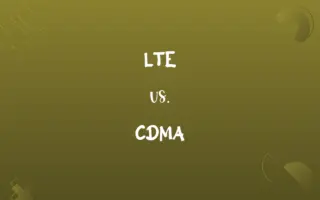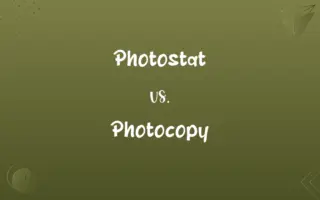Intrinsic Semiconductor vs. Extrinsic Semiconductor: Know the Difference

By Shumaila Saeed || Published on December 31, 2023
Intrinsic semiconductors are pure materials with their own charge carriers, while extrinsic semiconductors are doped with impurities to enhance conductivity.
Key Differences
Intrinsic semiconductors are pure forms of semiconductor materials, typically silicon or germanium, without any significant impurities added, while extrinsic semiconductors are the same materials but deliberately doped with impurities to modify their electrical properties. The electrical conductivity of intrinsic semiconductors is solely due to the movement of electrons and holes generated by thermal energy, whereas in extrinsic semiconductors, the conductivity significantly increases due to the added impurity atoms, which introduce additional charge carriers. This fundamental distinction highlights the difference in how intrinsic and extrinsic semiconductors conduct electricity, with intrinsic types relying on their inherent properties and extrinsic types leveraging controlled impurities.
Shumaila Saeed
Dec 31, 2023
The behavior of intrinsic semiconductors at different temperatures contrasts with that of extrinsic semiconductors. As the temperature increases, the conductivity of an intrinsic semiconductor increases because more electron-hole pairs are thermally generated. In contrast, the conductivity of extrinsic semiconductors is less sensitive to temperature changes, especially at lower temperatures, as the impurity levels provide a consistent source of charge carriers. This difference underlines the stability of extrinsic semiconductors in varied thermal environments compared to intrinsic semiconductors, whose performance is more reliant on temperature changes.
Shumaila Saeed
Dec 31, 2023
The electronic band structure of intrinsic semiconductors is characterized by a clear band gap between the valence band and the conduction band, with no additional energy levels. In contrast, extrinsic semiconductors have additional energy levels introduced within the band gap due to doping, which facilitates easier movement of electrons from the valence to the conduction band. This structural difference between intrinsic and extrinsic semiconductors underscores the impact of doping in reducing the energy required for electron movement, thereby enhancing conductivity.
Shumaila Saeed
Dec 31, 2023
Intrinsic semiconductors exhibit pure, undoped characteristics, making them ideal for applications where the material's inherent properties are crucial, such as in high-purity photodetectors or semiconductor research. Extrinsic semiconductors, however, are used in a vast array of electronic devices, from diodes to transistors, where controlled conductivity and specific electronic properties are required. This highlights the difference in application scope between intrinsic and extrinsic semiconductors, with the latter being more versatile and widely used in practical electronic applications.
Shumaila Saeed
Dec 31, 2023
The production process of intrinsic semiconductors demands a high level of purity and control to avoid unintentional doping, while extrinsic semiconductors require precise doping processes to introduce specific types and amounts of impurities. This distinction in manufacturing reflects the difference in complexity and purpose between intrinsic and extrinsic semiconductors: intrinsic semiconductors are valued for their unaltered, pure state, whereas extrinsic semiconductors are engineered to achieve desired electrical characteristics through doping.
Shumaila Saeed
Dec 31, 2023
ADVERTISEMENT
Comparison Chart
Conductivity
Lower, intrinsic charge carriers only
Higher, due to additional carriers from doping
Shumaila Saeed
Dec 31, 2023
Temperature Dependence
Increases with temperature
Varies, initially increases then stabilizes
Shumaila Saeed
Dec 31, 2023
Type of Charge Carriers
Electrons and holes (thermal generation)
Electrons (n-type) or holes (p-type) from doping
Shumaila Saeed
Dec 31, 2023
Common Uses
Limited in electronics due to lower conductivity
Extensively in electronics for enhanced conductivity
Shumaila Saeed
Dec 31, 2023
ADVERTISEMENT
Intrinsic Semiconductor and Extrinsic Semiconductor Definitions
Intrinsic Semiconductor
An intrinsic semiconductor is a pure, undoped semiconductor material.
Silicon in its pure form is an intrinsic semiconductor.
Shumaila Saeed
Dec 11, 2023
Extrinsic Semiconductor
The conductivity of extrinsic semiconductors is less sensitive to temperature.
Extrinsic semiconductors maintain steady conductivity across a range of temperatures.
Shumaila Saeed
Dec 11, 2023
Intrinsic Semiconductor
Intrinsic semiconductors conduct electricity using charge carriers generated internally.
Intrinsic semiconductors become more conductive at higher temperatures.
Shumaila Saeed
Dec 11, 2023
Extrinsic Semiconductor
Extrinsic semiconductors are divided into n-type and p-type based on doping.
Phosphorus doping in silicon creates an n-type extrinsic semiconductor.
Shumaila Saeed
Dec 11, 2023
Intrinsic Semiconductor
These semiconductors have an equal number of electrons and holes.
An intrinsic semiconductor's conductivity is limited by the number of electron-hole pairs it can generate.
Shumaila Saeed
Dec 11, 2023
ADVERTISEMENT
Extrinsic Semiconductor
An extrinsic semiconductor is a semiconductor material doped with impurities.
Adding boron to silicon creates a p-type extrinsic semiconductor.
Shumaila Saeed
Dec 11, 2023
Intrinsic Semiconductor
They have a narrow band gap energy.
The band gap of an intrinsic semiconductor determines its conductivity at different temperatures.
Shumaila Saeed
Dec 11, 2023
Extrinsic Semiconductor
These semiconductors have an imbalance of electrons and holes.
In an n-type extrinsic semiconductor, there are more electrons than holes.
Shumaila Saeed
Dec 11, 2023
Intrinsic Semiconductor
Intrinsic semiconductors are characterized by a perfect crystal lattice.
The crystal lattice of an intrinsic semiconductor lacks impurity atoms.
Shumaila Saeed
Dec 11, 2023
Extrinsic Semiconductor
Extrinsic semiconductors have higher conductivity than intrinsic ones.
Extrinsic semiconductors are used in transistors due to their enhanced conductivity.
Shumaila Saeed
Dec 11, 2023
Repeatedly Asked Queries
Are intrinsic semiconductors widely used in electronics?
No, their use is limited due to lower conductivity.
Shumaila Saeed
Dec 31, 2023
What types of charge carriers are in an intrinsic semiconductor?
Electrons and holes generated internally.
Shumaila Saeed
Dec 31, 2023
Can intrinsic semiconductors conduct electricity at low temperatures?
They conduct poorly at low temperatures.
Shumaila Saeed
Dec 31, 2023
How does temperature affect an intrinsic semiconductor?
Its conductivity increases with temperature.
Shumaila Saeed
Dec 31, 2023
How is conductivity in extrinsic semiconductors achieved?
Through additional charge carriers introduced by doping.
Shumaila Saeed
Dec 31, 2023
Is silicon an intrinsic semiconductor?
Pure silicon is, but it's often doped to make extrinsic semiconductors.
Shumaila Saeed
Dec 31, 2023
Are extrinsic semiconductors temperature-dependent?
Less than intrinsic; their conductivity is more stable across temperatures.
Shumaila Saeed
Dec 31, 2023
What happens to extrinsic semiconductors at very high temperatures?
They start to behave like intrinsic semiconductors.
Shumaila Saeed
Dec 31, 2023
What is an intrinsic semiconductor?
A pure semiconductor with no intentional doping.
Shumaila Saeed
Dec 31, 2023
What is an extrinsic semiconductor?
A semiconductor doped with impurities to enhance conductivity.
Shumaila Saeed
Dec 31, 2023
What are the types of extrinsic semiconductors?
N-type and p-type, based on the type of doping.
Shumaila Saeed
Dec 31, 2023
What is the role of impurities in extrinsic semiconductors?
To introduce additional charge carriers for improved conductivity.
Shumaila Saeed
Dec 31, 2023
Can extrinsic semiconductors be used in power electronics?
Yes, especially due to their high conductivity and stability.
Shumaila Saeed
Dec 31, 2023
Can intrinsic semiconductors be converted to extrinsic?
Yes, by doping them with specific impurities.
Shumaila Saeed
Dec 31, 2023
What is an acceptor impurity in extrinsic semiconductors?
An impurity that creates additional holes, used in p-type semiconductors.
Shumaila Saeed
Dec 31, 2023
What is a donor impurity in extrinsic semiconductors?
An impurity that adds extra electrons, used in n-type semiconductors.
Shumaila Saeed
Dec 31, 2023
Can the doping level in extrinsic semiconductors be controlled?
Yes, it's precisely controlled during the manufacturing process.
Shumaila Saeed
Dec 31, 2023
Do intrinsic semiconductors have a wider application than extrinsic ones?
No, extrinsic semiconductors have a wider range of applications due to their adjustable properties.
Shumaila Saeed
Dec 31, 2023
What makes extrinsic semiconductors preferable in electronic devices?
Their enhanced and controllable conductivity.
Shumaila Saeed
Dec 31, 2023
Why are extrinsic semiconductors more common in circuits?
Due to their reliable and enhanced electrical properties.
Shumaila Saeed
Dec 31, 2023
Share this page
Link for your blog / website
HTML
Link to share via messenger
About Author
Written by
Shumaila SaeedShumaila Saeed, an expert content creator with 6 years of experience, specializes in distilling complex topics into easily digestible comparisons, shining a light on the nuances that both inform and educate readers with clarity and accuracy.






































































